Dingle History Facts and Timeline
(Dingle, County Kerry, Ireland)
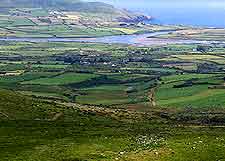
Dingle is reputed to be the most historic of the towns and villages that make up the Dingle Peninsula. It's thought that the earliest settlers in history arrived during the Stone Age. Today, relics of their activities can still be found. Certainly, the settlement's location made it ideal for fishing and cultivation of the soil.
In the Irish language, Dingle is 'Daingean Ui Chúis', which is often interpreted as 'fortress of Hussey', the Hussey family having arrived in the area after the Norman invasion of 1169. However, others argue that there is an alternative meaning that relates to a pre-Norman chieftain called O Cuis. Whichever you choose to believe, by the 13th century both Dingle and 'Daingean Ui Chúis' appear to have been in use.
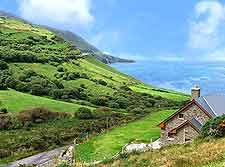
History from the Middle Ages to the 16th Century
Dingle was developed as a port by the Normans, who came to Ireland after they had consolidated their hold on England. Under their control, the town began to grow into a busy trading point, dealing in wool, fish, meat and butter.
Certainly, Dingle was wealthy enough by 1257 for King Henry III to impose a tax on the town's exports. During the Middle Ages, merchants' houses were built. In the 14th century, the town was ruled over by Maurice FitzGerald, the 1st Earl of Desmond.
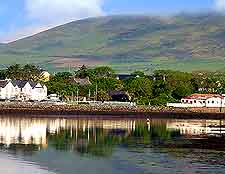
By the 16th century, history shows that Dingle had become one of the largest ports in Ireland. Its main export was wine, although its merchants also continued to deal in fish and hides.
Many European fleets also chose to anchor within its sheltered waters. During the latter part of the 16th century, the Dingle Peninsula became embroiled in the Second Desmond Rebellion, led by James FitzMaurice FitzGerald. Following the rebels' defeat, Queen Elizabeth I granted a charter to the town, allowing it to build its own walls.
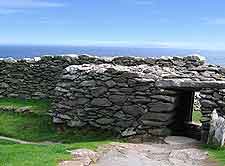
From the 18th Century to the Present
By the 18th century, Dingle had added a flourishing linen industry to its trading activities. Unfortunately, this was later to decline to almost nothing, with the arrival of competition from English cotton mills. From 1830 a fishing industry also grew up here.
This was a time of great famine in Ireland. Such hardships may well have served as a catalyst to the establishment of Dingle as a deep-water trawler port - a tradition that was to continue right through until the 20th century. The port had a great deal in its favour, including a sheltered harbour, access to the fertile fishing grounds of the Atlantic Ocean and proximity to the county town of Tralee.
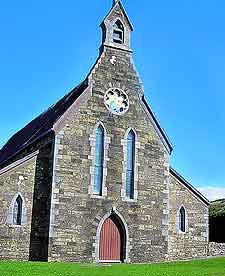
In 1888, the Tralee and Dingle Light Railway was incorporated. It took three yeas to build, and on its completion, fish and other exports could be transported much more easily. By 1925, however, the rail line had fallen into a poor state and, after the outbreak of World War Two, the line was closed to passenger trains. Cattle trucks continued to use it until the Dingle Fair of 1953, at which point the line was finally closed.
In 1969, the film 'Ryan's Daughter' was shot here, bringing the attractions of this small town and the Dingle Peninsula to the attention of a new audience. For most of the year, Dingle's population is around 2,500. However, over the years, tourism has become increasingly important to this small community and now, during the summer months, it is transformed into a busy seaside town.
 Dingle is reputed to be the most historic of the towns and villages that make up the Dingle Peninsula. It's thought that the earliest settlers in history arrived during the Stone Age. Today, relics of their activities can still be found. Certainly, the settlement's location made it ideal for fishing and cultivation of the soil.
Dingle is reputed to be the most historic of the towns and villages that make up the Dingle Peninsula. It's thought that the earliest settlers in history arrived during the Stone Age. Today, relics of their activities can still be found. Certainly, the settlement's location made it ideal for fishing and cultivation of the soil.
 By the 16th century, history shows that Dingle had become one of the largest ports in Ireland. Its main export was wine, although its merchants also continued to deal in fish and hides.
By the 16th century, history shows that Dingle had become one of the largest ports in Ireland. Its main export was wine, although its merchants also continued to deal in fish and hides.
 In 1888, the Tralee and Dingle Light Railway was incorporated. It took three yeas to build, and on its completion, fish and other exports could be transported much more easily. By 1925, however, the rail line had fallen into a poor state and, after the outbreak of World War Two, the line was closed to passenger trains. Cattle trucks continued to use it until the Dingle Fair of 1953, at which point the line was finally closed.
In 1888, the Tralee and Dingle Light Railway was incorporated. It took three yeas to build, and on its completion, fish and other exports could be transported much more easily. By 1925, however, the rail line had fallen into a poor state and, after the outbreak of World War Two, the line was closed to passenger trains. Cattle trucks continued to use it until the Dingle Fair of 1953, at which point the line was finally closed.